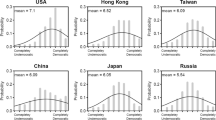Abstract
This article discusses the role of momentum in the primaries and the general election. The Republican nomination contest was consistent with the literature on momentum. As voters updated their knowledge of the candidates and their beliefs regarding the likelihood of victory, they switched their preferences to McCain, providing him with the surge that led him to victory. In the Democratic contest, no such momentum ever occurred. I will use empirical data to demonstrate that, throughout the entire process, the primary results were determined by the demographics of the state and candidate strategies. Even at the end, there was no rallying effect. In the general election, no momentum occurred until after the convention. Before then, the polls moved as a result of external shocks, but quickly reverted to equilibrium. I will explore the role of polarization, identity politics, and the early and intensive media coverage of the campaign in fixing voter opinions early in a manner that stifled momentum.
Similar content being viewed by others
Notes
Larry M. Bartels, Presidential Primaries and the Dynamics of Public Choice (Princeton: Princeton University Press, 1988).
William G. Mayer, “Forecasting Nominations,” in In Pursuit of the White House: How We Choose Our Presidential Nominees, ed. Mayer (Chatham NJ: Chatham House, 1996), 44–71.
See for example, Diana Mutz, “Mechanisms of Momentum: Does Thinking Make It So?” Journal of Politics 59 (1997), 104–25; Wayne P. Steger, Andrew J. Dowdle, and Randall E. Adkins, “The New Hampshire Effect in Presidential Nominations,” Political Research Quarterly 57 (2004): 375–90; Barbara Norrander, “The Attrition Game: Initial Resources, Initial Contests and the Exit of Candidates during the U.S. Presidential Primary Season,” British Journal of Political Science 36 (2006): 487–507; and Todd Donovan and Rob Hunsaker, “Beyond Expectations: Effects of Early Elections in U.S. Presidential Nomination Contests,” PS: Political Science and Politics 42 (2009): 45–52.
Marty Cohen, David Karol, Hans Noel and John Zaller, The Party Decides: Presidential Nominations Before and After Reform (Chicago: The University of Chicago Press, 2008).
For a more detailed description of this process see R. Lawrence Butler, Claiming the Mantle: How Presidential Nominations are Won and Lost Before the Votes are Cast (Boulder: CO: Westview Press, 2004), Chapter 5.
A more precise measure for these variables would have focused on people who voted in the Democratic contests or who were eligible to do so. However, exit poll data were not available for many states, nor are state demographic data by party affiliation.
Racial and age breakouts were drawn from Census Bureau estimates for July 2007.
Data on the percentage of college graduates in each state come from the 2000 Census.
We did not include a gender variable in the model because its value is relatively constant across states.
Bartels, Presidential Primaries and the Dynamics of Public Choice.
Author information
Authors and Affiliations
Rights and permissions
About this article
Cite this article
Butler, R. Momentum in the 2008 Presidential Contests. Polity 41, 331–344 (2009). https://doi.org/10.1057/pol.2009.11
Published:
Issue Date:
DOI: https://doi.org/10.1057/pol.2009.11




